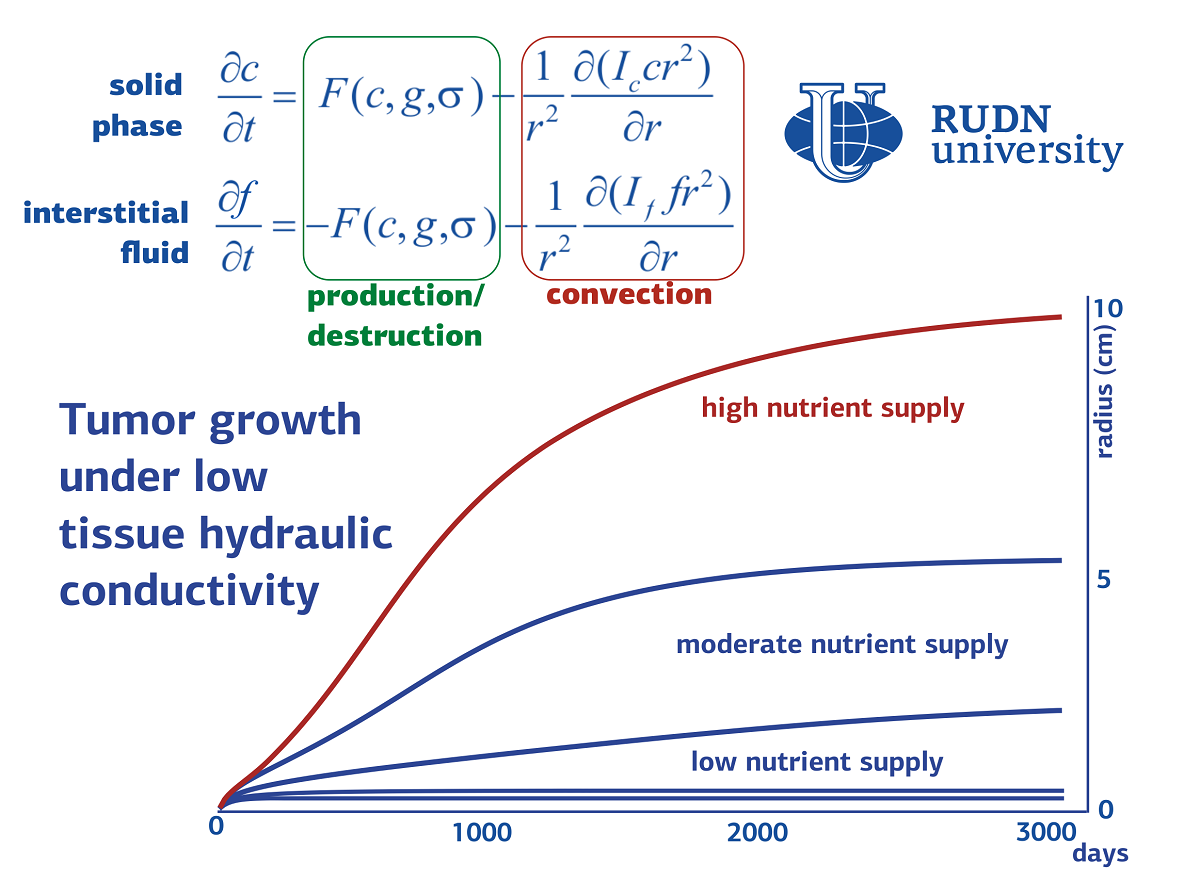Mathematicians report new model of tumor growth

The number of cells in a cancerous tumor should grow exponentially if the conditions are ideal for them. However, in real practice, such exponential growth is observed only in the early stages of tumor development. The main factors that limit tumor growth are the limitation of the nutrients supply and mechanical stress in the tissues. Mathematical models are used to study these processes. The mathematician from RUDN University proposed a simple mathematical model that takes into account these factors.
“Modeling tumor growth with an account of biomechanical properties is not a very popular area. One of the unexplored topics, to our knowledge, is the combined influence of both crucial growth-limiting factors—nutrient availability and mechanical stress—on tumor growth”, said Maxim Kuznetsov, Ph.D., junior researcher at the S.M. Nikol’skii Mathematical Institute of RUDN University.
The model developed by doctor Kuznetsov describes a tumor and healthy tissues around it as a combination of a solid substance (the porous matrix) and a liquid phase (interstitial fluid). The solid phase can be produced with the use of the liquid phase—this corresponds to the division of cancer cells. On the contrary, cell death corresponds to the transition of the solid phase to the liquid phase. At that, the rates of cell division and death depend on the level of nutrients and mechanical stress. The mathematician of RUDN University described such joint dynamics using a system of differential equations and then studied it analytically and numerically.
As a result, the mathematician discovered two phenomena. The first is the growth of the tumor to a gigantic size (reaching tens of centimeters in diameter in several years). In numerical calculations, this happened under a sufficiently high level of nutrient supply and sufficiently low hydraulic conductivity of the tissue (its property to pass fluid through its pores). Interestingly, such cases are described in real clinical practice. This can happen with tumors which growth is accompanied by abundant production of extracellular matrix.
The second phenomenon is the slowing down of tumor growth because of the mechanical stress at the lowest values of hydraulic conductivity. In such conditions, tumor growth at the first stage does not even depend on the level of nutrient supply. However, further, under a strong nutrient supply, an explosive growth acceleration can happen, so that the growth rate increases tenfold in a few years. Such cases do occur in clinical practice.
“The key task that will be focused on with the use of the developed version of the presented model is the optimization of various types of long-term tumor treatments, associated with the delivery of drugs to the tumor via intravenous injections. Consideration of biphasic tissue and the account for solid stress will allow reproducing adequately the dynamics of drugs and tumor during the course of therapy”, said Maxim Kuznetsov, Ph.D., junior researcher at the S.M. Nikol’skii Mathematical Institute of RUDN University.
The results are published in the journal Mathematics.
The project to develop a cellular model of the placenta became the winner in the Scientific Materials category of the Young Scientists 3.0 competition, organized with the support of the Presidential Grants Foundation and T-Bank.
Ten scientific journals published by RUDN University have been included in the highest level of the state list of scientific publications, the White List.
Forests are not only the lungs of the planet, but also home to millions of species. However, it has remained unclear how underground interactions between trees and fungi affect forest species richness in different climatic conditions. Previous studies have yielded conflicting results: in some regions, the dominance of certain fungi reduced tree diversity, while in others it increased it.
The project to develop a cellular model of the placenta became the winner in the Scientific Materials category of the Young Scientists 3.0 competition, organized with the support of the Presidential Grants Foundation and T-Bank.
Ten scientific journals published by RUDN University have been included in the highest level of the state list of scientific publications, the White List.
Forests are not only the lungs of the planet, but also home to millions of species. However, it has remained unclear how underground interactions between trees and fungi affect forest species richness in different climatic conditions. Previous studies have yielded conflicting results: in some regions, the dominance of certain fungi reduced tree diversity, while in others it increased it.